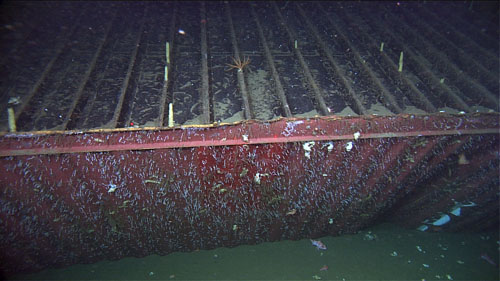You can read the daily cruise logs here
CRUISE BACKGROUND
June 4, 2014
Monterey, CA
Resting on the seafloor almost a mile below the surface of Monterey Bay lies a large shipping container, just one of 24 such containers that were lost at sea off the cargo ship M/V Med Taipei during a storm in February 2004. The ship was transiting from San Francisco to Los Angeles. This container was discovered by the Monterey Bay Aquarium Research Institute (MBARI) in June 2004, however, the locations of the other 23 containers remain a mystery.
This was not an isolated incident. Containerized maritime trade grew eight-fold from 1985 to 2007, and worldwide there are now approximately 5 to 6 million containers in transit at any given moment. Estimates of the number of shipping containers lost at sea range from the hundreds to the thousands, often due to the nexus of rough seas and inadequate or faulty securing mechanisms. Many containers are not weighed prior to loading, resulting in extreme forces being placed on container stacks when bad weather strikes. Depending on their cargo and the integrity of containers, they may float at the surface for several days or weeks prior to sinking. Unfortunately, it is not mandatory to report container losses to all relevant management agencies.
In March of 2011 and December 2013, the Monterey Bay National Marine Sanctuary (MBNMS), along with MBARI, used a deep-sea remotely-operated vehicle (ROV) to document the state of the container and its impact on the local ecology. This initial study showed an adverse affect to seafloor life of an area greater than 20 times its footprint. A mini-documentary about the 2011 research cruise can be viewed on YouTube, and more detailed project information can be found on the Sanctuary Integrated Monitoring Network as well as photos from the 2011 expedition.
MBNMS and MBARI will re-visit the container during a research cruise aboard the research vessel Western Flyer from June 5-9, 2014, once again led by Dr. Andrew DeVogelaere and Dr. Jim Barry. High-definition cameras aboard the ROV “Doc Ricketts” will become the scientists eyes, while the robotic arm and variety of collecting containers aboard the ROV will enable scientists to retrieve both animal and sediment samples for further analyses as well as place additional in-situ experiments. The main goals of this third visit to the container are:
- Assess the container’s current condition by gathering high-resolution imagery
- Describe sea life on the container and at different distances from it, to assess impacts
- To collect associated marine creatures on and near the container
- Continue to bring public attention to this deep-sea phenomenon that has been increasing with economic globalization and increased shipping
Although the visit to the shipping container is the highlight for MBNMS research staff, MBNMS will also be assisting Dr. Jim Barry in MBARI’s ongoing benthic ecology studies. These long-term studies are trying to determine whether deep-sea animals are more sensitive to climate change and ocean acidification than shallow water animals. More information about MBARI’s deep-sea benthic ecology studies can be found here.

Deep Sea Corals
During the 2013 expedition, we were the benefactors of fantastic weather, which allowed us to get in an extra day of diving at a place never looked at before: Sur Ridge. This small bump on the seafloor seemed to be potential habitat for deep-sea corals, much like the ones discovered on the Davidson Seamount in 2002. We were not disappointed. On our very first dive, we discovered a plethora of deep sea corals and sponges, clinging firmly to erosion-resistant volcanic rock from the base of the ridge to the top. Corals are suspension feeders; the colony uses its individual polyps to grab particles of food out of the water. Since higher water flow means more food, corals are found on peaks, ridges, and areas of sharp slope change, as water is generally flowing faster up these features, bringing food with it. Sur Ridge represents only the second location within Monterey Bay National Marine Sanctuary that deep-sea corals have been found.
No Sun Needed Here
On a subsequent dive on the southern portion of the ridge near the summit, we discovered several locations of vescomyid clams. This is a special family of clams that have formed a symbiotic relationship with chemosynthetic bacteria that live inside its gut. It’s a complex chain of events, but essentially, these bacteria convert sulfides into energy for the clam. These sulfides only come from three known sources in the ocean (thus far): cold seeps, hydrothermal vents, and whale falls. Cold seeps area areas where fluid methane escapes through fissures in the rock. Bacteria living within the sediment at cold seeps or colonies that digest whale bones use methane as their energy source to convert sulfates into sulfides, which are then in turn used by the symbiotic bacteria. Symbiotic bacteria near hydrothermal vents, on the other hand, use hydrogen sulfide that is coming directly out of the vent. There are no hydrothermal vents on this part of the coast, and although there are clams on whale falls, they are of a different species.
The public can follow this exciting expedition with daily cruise logs, as well as the MBNMS Facebook Page.
A video production of this research expedition will eventually air on “Your Sanctuary TV” in 2014 or 2015. You can visit YourSanctuaryTV.org for past episodes.

